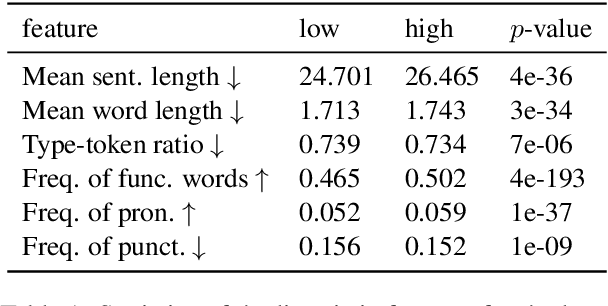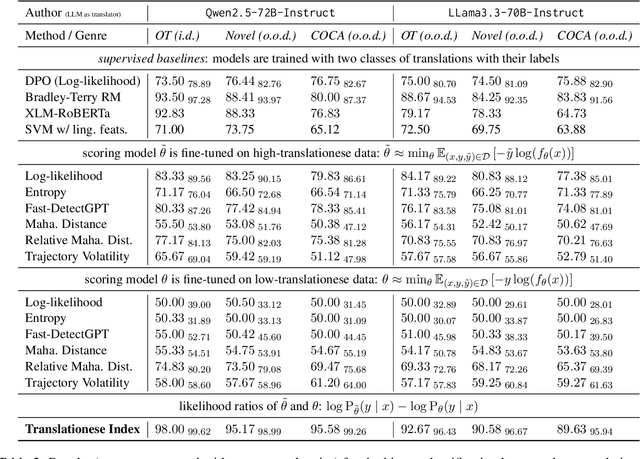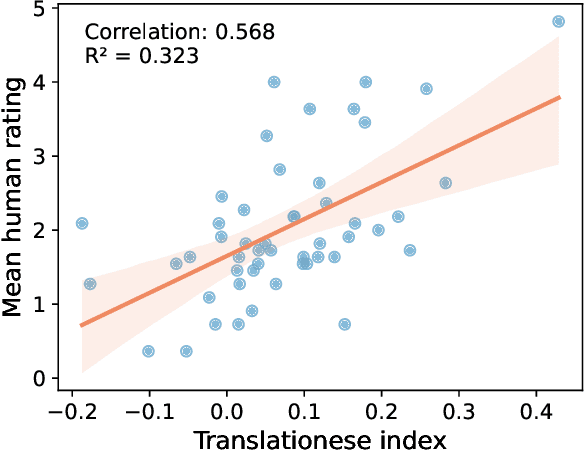Baosong Yang
additional authors not shown
Qwen3Guard Technical Report
Oct 16, 2025Abstract:As large language models (LLMs) become more capable and widely used, ensuring the safety of their outputs is increasingly critical. Existing guardrail models, though useful in static evaluation settings, face two major limitations in real-world applications: (1) they typically output only binary "safe/unsafe" labels, which can be interpreted inconsistently across diverse safety policies, rendering them incapable of accommodating varying safety tolerances across domains; and (2) they require complete model outputs before performing safety checks, making them fundamentally incompatible with streaming LLM inference, thereby preventing timely intervention during generation and increasing exposure to harmful partial outputs. To address these challenges, we present Qwen3Guard, a series of multilingual safety guardrail models with two specialized variants: Generative Qwen3Guard, which casts safety classification as an instruction-following task to enable fine-grained tri-class judgments (safe, controversial, unsafe); and Stream Qwen3Guard, which introduces a token-level classification head for real-time safety monitoring during incremental text generation. Both variants are available in three sizes (0.6B, 4B, and 8B parameters) and support up to 119 languages and dialects, providing comprehensive, scalable, and low-latency safety moderation for global LLM deployments. Evaluated across English, Chinese, and multilingual benchmarks, Qwen3Guard achieves state-of-the-art performance in both prompt and response safety classification. All models are released under the Apache 2.0 license for public use.
Direct Simultaneous Translation Activation for Large Audio-Language Models
Sep 19, 2025



Abstract:Simultaneous speech-to-text translation (Simul-S2TT) aims to translate speech into target text in real time, outputting translations while receiving source speech input, rather than waiting for the entire utterance to be spoken. Simul-S2TT research often modifies model architectures to implement read-write strategies. However, with the rise of large audio-language models (LALMs), a key challenge is how to directly activate Simul-S2TT capabilities in base models without additional architectural changes. In this paper, we introduce {\bf Simul}taneous {\bf S}elf-{\bf A}ugmentation ({\bf SimulSA}), a strategy that utilizes LALMs' inherent capabilities to obtain simultaneous data by randomly truncating speech and constructing partially aligned translation. By incorporating them into offline SFT data, SimulSA effectively bridges the distribution gap between offline translation during pretraining and simultaneous translation during inference. Experimental results demonstrate that augmenting only about {\bf 1\%} of the simultaneous data, compared to the full offline SFT data, can significantly activate LALMs' Simul-S2TT capabilities without modifications to model architecture or decoding strategy.
Translationese-index: Using Likelihood Ratios for Graded and Generalizable Measurement of Translationese
Jul 16, 2025



Abstract:In this paper, we propose the first quantitative measure for translationese -- the translationese-index (T-index) for graded and generalizable measurement of translationese, computed from the likelihood ratios of two contrastively fine-tuned language models (LMs). We use a synthesized dataset and a dataset with translations in the wild to evaluate T-index's generalizability in cross-domain settings and its validity against human judgments. Our results show that T-index is both robust and efficient. T-index scored by two 0.5B LMs fine-tuned on only 1-5k pairs of synthetic data can well capture translationese in the wild. We find that the relative differences in T-indices between translations can well predict pairwise translationese annotations obtained from human annotators; and the absolute values of T-indices correlate well with human ratings of degrees of translationese (Pearson's $r = 0.568$). Additionally, the correlation between T-index and existing machine translation (MT) quality estimation (QE) metrics such as BLEU and COMET is low, suggesting that T-index is not covered by these metrics and can serve as a complementary metric in MT QE.
Qwen3 Embedding: Advancing Text Embedding and Reranking Through Foundation Models
Jun 05, 2025



Abstract:In this work, we introduce the Qwen3 Embedding series, a significant advancement over its predecessor, the GTE-Qwen series, in text embedding and reranking capabilities, built upon the Qwen3 foundation models. Leveraging the Qwen3 LLMs' robust capabilities in multilingual text understanding and generation, our innovative multi-stage training pipeline combines large-scale unsupervised pre-training with supervised fine-tuning on high-quality datasets. Effective model merging strategies further ensure the robustness and adaptability of the Qwen3 Embedding series. During the training process, the Qwen3 LLMs serve not only as backbone models but also play a crucial role in synthesizing high-quality, rich, and diverse training data across multiple domains and languages, thus enhancing the training pipeline. The Qwen3 Embedding series offers a spectrum of model sizes (0.6B, 4B, 8B) for both embedding and reranking tasks, addressing diverse deployment scenarios where users can optimize for either efficiency or effectiveness. Empirical evaluations demonstrate that the Qwen3 Embedding series achieves state-of-the-art results across diverse benchmarks. Notably, it excels on the multilingual evaluation benchmark MTEB for text embedding, as well as in various retrieval tasks, including code retrieval, cross-lingual retrieval and multilingual retrieval. To facilitate reproducibility and promote community-driven research and development, the Qwen3 Embedding models are publicly available under the Apache 2.0 license.
ConText: Driving In-context Learning for Text Removal and Segmentation
Jun 04, 2025Abstract:This paper presents the first study on adapting the visual in-context learning (V-ICL) paradigm to optical character recognition tasks, specifically focusing on text removal and segmentation. Most existing V-ICL generalists employ a reasoning-as-reconstruction approach: they turn to using a straightforward image-label compositor as the prompt and query input, and then masking the query label to generate the desired output. This direct prompt confines the model to a challenging single-step reasoning process. To address this, we propose a task-chaining compositor in the form of image-removal-segmentation, providing an enhanced prompt that elicits reasoning with enriched intermediates. Additionally, we introduce context-aware aggregation, integrating the chained prompt pattern into the latent query representation, thereby strengthening the model's in-context reasoning. We also consider the issue of visual heterogeneity, which complicates the selection of homogeneous demonstrations in text recognition. Accordingly, this is effectively addressed through a simple self-prompting strategy, preventing the model's in-context learnability from devolving into specialist-like, context-free inference. Collectively, these insights culminate in our ConText model, which achieves new state-of-the-art across both in- and out-of-domain benchmarks. The code is available at https://github.com/Ferenas/ConText.
Qwen3 Technical Report
May 14, 2025



Abstract:In this work, we present Qwen3, the latest version of the Qwen model family. Qwen3 comprises a series of large language models (LLMs) designed to advance performance, efficiency, and multilingual capabilities. The Qwen3 series includes models of both dense and Mixture-of-Expert (MoE) architectures, with parameter scales ranging from 0.6 to 235 billion. A key innovation in Qwen3 is the integration of thinking mode (for complex, multi-step reasoning) and non-thinking mode (for rapid, context-driven responses) into a unified framework. This eliminates the need to switch between different models--such as chat-optimized models (e.g., GPT-4o) and dedicated reasoning models (e.g., QwQ-32B)--and enables dynamic mode switching based on user queries or chat templates. Meanwhile, Qwen3 introduces a thinking budget mechanism, allowing users to allocate computational resources adaptively during inference, thereby balancing latency and performance based on task complexity. Moreover, by leveraging the knowledge from the flagship models, we significantly reduce the computational resources required to build smaller-scale models, while ensuring their highly competitive performance. Empirical evaluations demonstrate that Qwen3 achieves state-of-the-art results across diverse benchmarks, including tasks in code generation, mathematical reasoning, agent tasks, etc., competitive against larger MoE models and proprietary models. Compared to its predecessor Qwen2.5, Qwen3 expands multilingual support from 29 to 119 languages and dialects, enhancing global accessibility through improved cross-lingual understanding and generation capabilities. To facilitate reproducibility and community-driven research and development, all Qwen3 models are publicly accessible under Apache 2.0.
Unveiling Language-Specific Features in Large Language Models via Sparse Autoencoders
May 08, 2025



Abstract:The mechanisms behind multilingual capabilities in Large Language Models (LLMs) have been examined using neuron-based or internal-activation-based methods. However, these methods often face challenges such as superposition and layer-wise activation variance, which limit their reliability. Sparse Autoencoders (SAEs) offer a more nuanced analysis by decomposing the activations of LLMs into sparse linear combination of SAE features. We introduce a novel metric to assess the monolinguality of features obtained from SAEs, discovering that some features are strongly related to specific languages. Additionally, we show that ablating these SAE features only significantly reduces abilities in one language of LLMs, leaving others almost unaffected. Interestingly, we find some languages have multiple synergistic SAE features, and ablating them together yields greater improvement than ablating individually. Moreover, we leverage these SAE-derived language-specific features to enhance steering vectors, achieving control over the language generated by LLMs.
PolyMath: Evaluating Mathematical Reasoning in Multilingual Contexts
Apr 30, 2025Abstract:In this paper, we introduce PolyMath, a multilingual mathematical reasoning benchmark covering 18 languages and 4 easy-to-hard difficulty levels. Our benchmark ensures difficulty comprehensiveness, language diversity, and high-quality translation, making it a highly discriminative multilingual mathematical benchmark in the era of reasoning LLMs. We conduct a comprehensive evaluation for advanced LLMs and find that even Qwen-3-235B-A22B-Thinking and Gemini-2.5-pro, achieve only 54.6 and 52.2 benchmark scores, with about 40% accuracy under the highest level From a language perspective, our benchmark reveals several key challenges of LLMs in multilingual reasoning: (1) Reasoning performance varies widely across languages for current LLMs; (2) Input-output language consistency is low in reasoning LLMs and may be correlated with performance; (3) The thinking length differs significantly by language for current LLMs. Additionally, we demonstrate that controlling the output language in the instructions has the potential to affect reasoning performance, especially for some low-resource languages, suggesting a promising direction for improving multilingual capabilities in LLMs.
Enhancing LLM Language Adaption through Cross-lingual In-Context Pre-training
Apr 29, 2025Abstract:Large language models (LLMs) exhibit remarkable multilingual capabilities despite English-dominated pre-training, attributed to cross-lingual mechanisms during pre-training. Existing methods for enhancing cross-lingual transfer remain constrained by parallel resources, suffering from limited linguistic and domain coverage. We propose Cross-lingual In-context Pre-training (CrossIC-PT), a simple and scalable approach that enhances cross-lingual transfer by leveraging semantically related bilingual texts via simple next-word prediction. We construct CrossIC-PT samples by interleaving semantic-related bilingual Wikipedia documents into a single context window. To access window size constraints, we implement a systematic segmentation policy to split long bilingual document pairs into chunks while adjusting the sliding window mechanism to preserve contextual coherence. We further extend data availability through a semantic retrieval framework to construct CrossIC-PT samples from web-crawled corpus. Experimental results demonstrate that CrossIC-PT improves multilingual performance on three models (Llama-3.1-8B, Qwen2.5-7B, and Qwen2.5-1.5B) across six target languages, yielding performance gains of 3.79%, 3.99%, and 1.95%, respectively, with additional improvements after data augmentation.
Sampling-Efficient Test-Time Scaling: Self-Estimating the Best-of-N Sampling in Early Decoding
Mar 03, 2025



Abstract:Test-time scaling improves large language model performance by adding extra compute during decoding. Best-of-N (BoN) sampling serves as a common scaling technique, broadening the search space for finding better solutions from the model distribution. However, traditional BoN requires N full generations, leading to high GPU memory overhead and time latency. Moreover, some methods depend on reward models, adding computational cost and limiting domain generalization. In this paper, we propose Self-Truncation Best-of-N (ST-BoN), a novel decoding method that avoids fully generating all samplings and eliminates the need for reward models. ST-BoN introduces early sampling consistency to estimate the most promising sample, truncating suboptimal ones to free memory and accelerate inference. This pushes the sampling-efficient test-time scaling. Compared to traditional BoN, ST-BoN can reduce dynamic GPU memory overhead by over 90% and time latency by 50%, while achieving comparable or even better performance across reasoning and open-ended domains.
 Add to Chrome
Add to Chrome Add to Firefox
Add to Firefox Add to Edge
Add to Edge